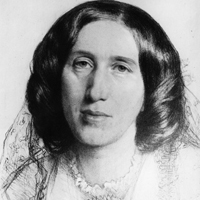Social Realism in George Eliot's Adam Bede
George Eliot's Adam Bede is a realistic novel of Victorian society, including the social problem of highlighting the poor social presentation together with the retrace of rural areas of the country. Adam Bede is an example of Victorian literature aiming to reflect the social realism.

Mary Ann Evans (George Eliot)
Almost every literary genre of Victorian literature is engaged to reflect the realism of the contemporary society. So does this novel too.
At the central position of Eliot's Adam Bede there lies the basic tenant of social realism. The very rigid Victorian society has been reflected in the novel. The entire gamut of Victorian literature is inseparably linked with realism. Poetry, novel, drama and all pieces of Victorian writings are engaged in the representation of realism of either kind. In the same vein, George Eliot's Adam Bede aims at representing social realism. At the core of Adam Bede lies the basic tenant of social realism. Let's examine the narrative where the fundamental tenant of social realism lies.
Victorian society was rigid. It had a strict view concerning women. Victorian society was afflicted with blazes and prejudices. It has baize against women. If any women tried to move in the world of freedom and employment, she was mocked and ridiculed. Women were also expected to work in confined circles live household work. In this novel George Eliot represented a character Dinah Morris. She was a Methodist preacher. When Dinah Morris becomes a preacher, many people indirectly criticized her. Dinah Morris was beautiful in appearance. People were attracted towards her. Many people used to listen to her preaching. But it was simply pretense. They actually went to listen to her because they were actually tempted to see her beautiful face. Most of those who attempted Dinah Morris's preaching were hypocritical, under the mask of religious devotion of those Sermon listeners ran the sexual intention and corrupt selfish psyche.
Victorian age was the age of Thomas Carlyle. Carlyle was extremely critical of the growing Victorian attachment with materialism. People were distractingly crazy for comfort and happiness. They hardly believed in the dignity of work. Victorian people were neglectful of the fact that the worker should derive pride and joy from the work they do. During Victorian times the workers were becoming increasingly mechanical. To correct his age Carlyle introduced, the most repeated and very much hallowed maximum work is worship. To work is equal to worshipping, God. Through your absolute belief in work you can make God happy. It is a work which links you with God. The impact of this maxim of Carlyle was unbelievably pervasive. George Eliot must certainly have been influenced by the motto of Carlyle work is worship. That is why her character Adam Bede is shown climbing the ladder of social success by virtue of his belief in the work. Adam Bede is a carpenter. He has achieved excellence in his profession. He was popular as a good carpenter. His name spread far and near. Due to his growing popularity, he was invited to attend the birthday party of Arthur Donnithorne. Even the owner of Hall farm was eager to accept Adam Bede as a partner. Adam had a vision to leave the world more livable for the further progeny through cultivating an eternal belief and pride in the work. Respect, dignity and prestige, not from birth, but from good and excellent deeds were the guiding principle of Adam Bede. And Eliot shows Adam is successful in society by virtue of his cherished beliefs and ideals. From this view point also we can catch a glimpse of one extra brand of social realism.
Social chasm was another problem. The vestige of feudalism was still alive in Hayslope village. Hetty Sorrel belonged to the working class. Arthur Donnithorne belonged to the feudal class. Feudal class had still certain fascinating charm of the working class people. Hetty Sorrel was madly attracted to Arthur Donnithorne. She was from a poor family. Her family background was not nice. So she had a dream to marry Arthur Donnithorne and be a wife of a respectable feudal man. But such a fantasy driven effort by Hetty ruined her own life. Her tragic end created a deep wound in the psyche of Hayslope people. This accident in the personal life of Hetty Sorrel suggests one bran of harsh reality the society faces when two different, unequal classes try to meet at a point through emotion not through reason.
Social realism in the novel is depicted as the characters were conscious of their class status at a significant social gathering. At the time of Arthur Donnithorne's birthday several people came to see and celebrate their feudal master's son's birthday. People were represented as conscious of their class background. Only Adam was given a respectable place in the birthday celebration because Adam had elevated his position through hard work and labor. This moment of birthday celebrations serves as screen in which social realism concerning the class consciousness of several people get reflected. In this way, whether it is the position of Adam or it is the position of caption Donnithrone or Dinah or Hetty, even characters gives a symbolic reflection of Victorian society. Their depiction has been highly colored with the image of Victorian society. Overall novel is realistic. It includes the elements like realistic, social presentation, reflection of social problems, highlighting the poor people, setting in rural areas, presentation of Victorian morality, sense of brotherhood, religious, truth etc. are objective correlative to show the social realism in Eliot's Adam Bede.
Literary Spotlight
Introduction of Eliot's Adam Bede
Determinism in Eliot's Adam Bede
Moral Concerns in Eliot's Adam Bede
Rustic Scenes in Eliot's Adam Bede
Narrative Technique in Eliot's Adam Bede
Study of Female Protagonist in Adam Bede
Comparative Study of Hetty and Hester
Image and Symbols in Eliot's Adam Bede
Multiple Themes in Eliot's Adam Bede
 |
bachelorandmaster.com |